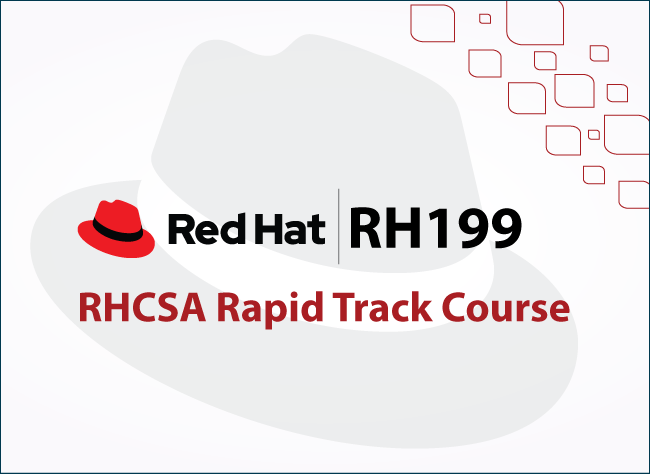- Home
- Infos Courses

RH199 - RHCSA Rapid Track Course
Learn essential Red Hat Enterprise Linux 8 tasks and methods in a condensed format
The RHCSA Rapid Track course (RH199) combines the foundations and applications established and covered in Red Hat System Administration I (RH124) and Red Hat System Administration II (RH134). The rapid pace of review and consolidated course timeline allow you to focus on practical application, making this offering best suited to those who already have significant experience with Linux® administration.
This course is based on Red Hat® Enterprise Linux 8.
Durée: 4 Days
COURSE PROGRAM
Learn essential Red Hat Enterprise Linux 8 tasks and methods in a condensed format
The RHCSA Rapid Track course (RH199) combines the foundations and applications established and covered in Red Hat System Administration I (RH124) and Red Hat System Administration II (RH134). The rapid pace of review and consolidated course timeline allow you to focus on practical application, making this offering best suited to those who already have significant experience with Linux® administration.
This course is based on Red Hat® Enterprise Linux 8.
- Package management with new repository structure and appstream modules
- Create storage devices, volumes, and file systems, including Stratis storage management
- Configure network services and security
- Manage processes, scheduling, and tuning
- Manage users, groups, and authentication
- Perform server management with the Cockpit web management utility
- Troubleshoot and obtain support
This course is geared toward Windows system administrators, network administrators, and other system administrators who are interested in supplementing current skills or backstopping other team members, in addition to Linux system administrators who are responsible for these tasks:
- Configuring, installing, upgrading, and maintaining Linux systems using established standards and procedures
- Providing operational support
- Managing systems for monitoring system performance and availability
- Writing and deploying scripts for task automation and system administration
- You will be expected to already understand fundamental Linux computing concepts and be ready to practice the Red Hat Enterprise Linux methods for performing system administration tasks. Significant field experience working with Linux as a system administrator is recommended.
- If you do not have experience with fundamental Linux computer concepts, we advise you to start with the Red Hat System Administration I (RH124) course instead.
- Red Hat Certified System Administrator exam (EX200)
- Red Hat System Administration III: Linux Automation (RH294)
Access systems and get help
Log in to local and remote Linux systems, and investigate problem resolution methods provided through Red Hat Insights and support.
Navigate file systems
Copy, move, create, delete, and organize files while working from the bash shell.
Manage local users and groups
Create, manage, and delete local users and groups and administer local password policies.
Control access to files
Set Linux file system permissions on files and to interpret the security effects of different permission settings.
Manage SELinux security
Protect and manage the security of a server by using SELinux.
Tune system performance
Evaluate and control processes, set tuning parameters, and adjust process scheduling priorities on a Red Hat Enterprise Linux system.
Install and update software packages
Download, install, update, and manage software packages from Red Hat and yum package repositories.
Manage basic storage
Create and manage storage devices, partitions, file systems, and swap spaces from the command line.
Control services and the boot process
Control and monitor network services, system daemons, and the boot process using systemd.
Manage networking
Configure network interfaces and settings on Red Hat Enterprise Linux servers.
Analyze and store logs
Locate and accurately interpret logs of system events for troubleshooting purposes.
Implement advanced storage features
Create and manage logical volumes containing file systems and swap spaces from the command line, and configure advanced storage features with Stratis and VDO.
Schedule future tasks
Schedule tasks to automatically execute in the future.
Access network-attached storage
Access network-attached storage, using the NFS protocol.
Manage network security
Control network connections to services using the system firewall and SELinux rules.
